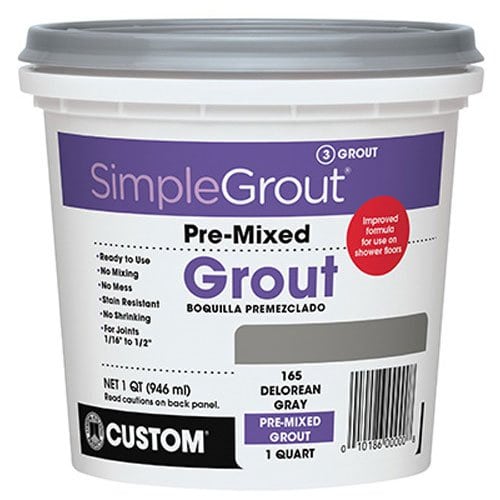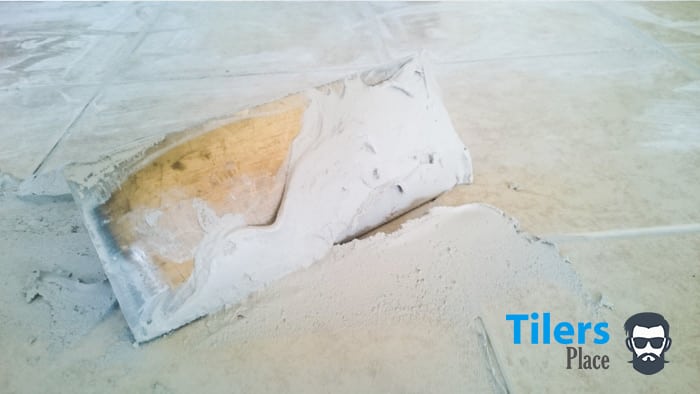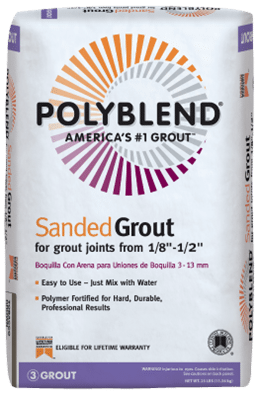Table Of Contents
Tilers Place is reader-supported. When you buy through links on this page, I may earn an affiliate commission on qualifying purchases.
What Causes Grout Discoloration?
Full Indepth Guide To Inconsistent Grout Color And Tips On How To Fix It
Why do I have grout discoloration!?!
I can hear you scream it while tearing out your hair in frustration and holding back a tear of disappointment.
I know the pain, you’ve spent all that money on getting tile installed, took your time picking out a tile that will look amazing in your home and after all is said and done – it looks terrible.
Today I will explain why your grout color is consistent and most importantly, how to fix it. I’ve got some explaining to do so bare with me – this isn’t a “get the answer quick and run off” sort of article as you need to understand how grout works in order to fix the problem and prevent it happening again. Nonetheless, I’ll provide a quick and dirty answer if you’re really pressed for time.

Hi there, my name is Carl and welcome to tilersplace.com.
At this point, I should have called it Groutplace.com as I write about grout more than anything else! Considering it’s one of the most variable and inconsistent parts of tiling, I can see why everyone has so many questions about it!
Today I’ll be sharing my knowledge of 25 years as a tiler and explaining a common tiling headache – inconsistent and patchy grout color.
Why Is My Grout Color Uneven? (Quick Answer)
Why: The tile grout was applied incorrectly and the color pigments in the grout were washed out in various areas.
How To Fix Patchy Grout Quickly: You can fix discolored grout by removing the trouble spots and regrouting it properly. Alternatively you can use an epoxy grout stain and go over all the grout to achieve a uniform color.
What Is Grout?

Before we go into patchy colored grout and all that, I want to teach you the fundamentals so that you get a proper understanding about what we are dealing with here.
To put it simply, tile grout is a powdered compound that is composed of Portland cement, refined sand and colored pigments.
Most modern grouts now also have additional mold inhibitors and other chemicals that help combat mildew growth and help keep grout looking nicer for longer.
Most grouts come as a dry powder like cement and water is added to them in order for them to be workable and able to get pushed into grout lines. Through natural curing, the grout dries and turns hard after 24 hours or so.
Grout on the whole is a cementitious substance, it’s rough, porous and can absorb dirt and nasties like any other cement compound.
There are some notable exceptions like epoxy grout that come in two or three parts. The filler powder is already moist and you add a resin and color pigment to it.
This mixture is then ready to be used as grout and is much stronger and resilient over traditional grout. Epoxy grout never comes out patchy, especially in two part epoxy grouts but comes with a steep difficulty curve and requires a lot of care.
Once epoxy grout dries, nothing short of an angle grinder will remove it from tiles, furniture, your hands.
Is it hard to use? Definitely! Is the effort worth it? Definitely!
The decision is yours to make.

There are also some ready to use grouts that come in tubs and do not require water. They are designed for first timers and DIY use. I’ve never used these for professional use as they have a track record of not curing properly and generally providing poor results. I could never recommend them to you or anyone else.
If you want to learn more about tile grout, you can read my Grout Wiki here.
How Is Grout Applied?
I won’t go into a full blown grouting tutorial (I have one here) but let’s look at the basics.
Grout is mixed with clean water into a peanut butter like substance. This substance is then pushed into the grout joints using a rubber float and flattened out so it’s smooth with the tile edges.

This of course makes a mess on the surface of the tiles and the grout lines need smoothing out to be neat and without any creases or imperfections.
A wet sponge is then used to wash away the excess grout and to smoothen out the grout lines. This is done by running the sponge over the grout lines in a smooth motion. Once the sponge is messy with grout, it gets rinsed and the process repeated until the tile is clean.
The tiles then dry off and a light grout haze is left on the tiles. This gets buffed off with a rag and the tiles are grouted.
The grout continues to dry and solidify like cement or plaster.
Why Is Grout Important In A Tile Installation?

Grout is an integral part of all tile installations. Tile as a medium requires grout joints around the tiles to signify that this surface is tiled and it’s the very essence of tile.
Tiles + Grout = A Real Tile Installation.
Of course, there’s a more practical use for grout that isn’t tied to appearance.
Grout lines give flexibility and allow movement between the tiles.
While it’s not noticeable with the human eye, tiles do flex and move with time or with traffic. The spaces between the tiles allow tiles to move freely and not grind against each other. This is especially important on floor tile or in areas subject to thermal stresses like walls backed by the outdoors, fireplaces or steam rooms.
I have had many clients over the years ask me if I can install the tiles with no grout joints and I have always refused for that practical reason. I can never sign my name onto a tile job that will definitely fail prematurely.
Tiles need to be spaced out and the grout between them fills out those gaps. It’s the nature of tiles and that’s how it has to be.
Okay, so now you understand what grout is and why it’s even there in the first place, now let’s take a look at why your color is inconsistent and botchy.
Why Is My Grout Color Inconsistent?
There are a few reasons that may cause grout to dry with various shades of the base color. Let’s go through them all to help identify the problem. If you installed the grout yourself, this will be a great learning exercise and hopefully give you insight into what went wrong.
If you had a professional tiler or company install your tile and grout, then you will gain from learning about this subject as well. Knowledge is power after all and it’s cool to understand how things work.

The list starts with the most common cause of irregular grout color and proceeds from there. All these cases can cause grout discoloration but number 1 is the most common culprit.
1- Too Much Water Was Used During Washing Up
Remember earlier when I mentioned that grout is made up of various things, one being color pigments?
Yup, well those color pigments can get washed out during the grouting phase.
Color pigments are just tiny flecks of color that disolve and mix into things and they can be washed away with water.
Natural grout colors like grey or white are less likely to get washed out as the grout components naturally occur in those colors, the pigments then regulate their shade. White grout is made from refined white silica sand.
So What Went Wrong?
The installer made a critical error during the washing up stage and too much water was introduced. This could either have been from the sponge being too wet or too much passes were made with the sponge over the wet grout.
The color pigments were simply washed out of the grout.
Some areas would see more sponge passes over others, it’s just how human nature works. No one counts the exact sponge wipes over one tile and repeats it. It’s random. Plus, some tiles may be more dirty than others and would have received more sponge passes over others that washed away easily.
Think about how you wash your car.
You don’t count how many times you run the sponge over a body panel do you?
No.
You see the dirt and attack it with your soapy sponge. Some areas like the doors will be dirtier than the bonnet so they receive more attention.
The crucial difference is that car paint is dry and the color won’t run, where as grout is still wet and the color pigments haven’t been locked in place yet.
The common mistake is that a beginner tiler or careless professional will treat the grout the same way they’d treat anything else that’s dirty, forgetting that grout simply can’t be treated like that.
Crumbling or Weak Grout
Another side effect of too much water being used is that the grout can dry out flakey and weak. It can crumble out prematurely or never cure to full strength.
This is because all that cement and polymers that give the grout strength were washed out, leaving behind some sand and not enough hardeners to properly bind everything out.
People asking “why is my new grout crumbling?” Here’s your answer.
Phew, that was a long explanation, did you understand all that?
Basically, the color in the grout was diluted and washed out in areas. Simple.
2 – Grout Was Mixed Incorrectly
Believe it or not, grout can be mixed incorrectly.
The easiest mistake to make is not following the instructions on the packet is too much water was mixed into the grout.
Improper mixing of the grout can also be responsible.
The color pigments need to be properly distributed around the mix to provide an even color. A lot of grout is mixed by hand using a margin trowel and since it’s a manual effort, it may have not been mixed enough.
One way of avoiding this is by using a mixing drill with a small mixing paddle on a slow speed. Alternatively, just take your time mixing the grout with a margin trowel and it should be fine. I use this method 99% of the time and never have problems.
3 – Difference In Drying Time
The drying time of grout in a new tile installation can also effect the color.
This is especially a factor if a heater was used to speed up the curing of the grout.
It is not uncommon for a heater to be used so that the grout “flashes off” faster and for the grout haze to appear. Because a tile job is never finished until the grout haze is removed and the silicone sealant applied, a heater or fan can be used to speed the drying process up.
While this in itself isn’t bad, leaving the heater in one area for too long will cause color issues. One patch will get cooked and go lighter while another will cure naturally and retain a darker look.
Even a draft of wind or shaft of sun hitting one area of the floor or wall and not the other can create some difference in grout color due to the difference in drying time.
4 – Old Grout

Every good warehouse manager will tell you that stock rotation is a must and construction materials are no different.
The reason your grout color is inconsistent could not even be your (or the professional’s) fault. If the grout was old upon purchasing it, then it could very likely not cure properly and end up patchy.
Every tiling product has a shelf life and when they pass that date, weird things can happen because the components just won’t work properly.
I had a job where the grout never cured properly and it literally crumbled out of the joints.
I sent that grout batch number to the manufacturer, they checked it out and it turned out it was way past it’s shelf life even though I purchased it a day before installing.
This is definitely the less common issue as most stores are amazing with stock rotation and keeping up with things but things happen.
How Do I fix Grout Discoloration?
So now you know why color can be patchy and what causes it, but how do you fix it?
There are two ways that you can fix uneven grout color.
My preferred method would be to remove the worst patches of grout and regrouting them with the same grout that was used. This new grout (if applied correctly without getting washed out) should match up well with the older grout and blend in. You will never get a 1/1 color match like paint, but it will be enough to not be as eye catching as what you had before.
You can use a grout saw or an oscillating multi-tool with a grout removal blade to remove the grout.
I have exhaustive articles on removing grout with either of those tools so you’ll know everything that I know about their use.
Check Out My Grout Removal Guides
Another method is using an epoxy grout colorant and painting over the grout.
This technique will provide a more uniform color but isn’t necessarily easier. For one, you’ll need to paint over all the grout in the area and also be careful not to go over the lines and paint the tiles. It is generally faster than the first method however.
One thing to note with grout colorant is that it’s not permanent, especially on a floor. I know, cause I applied it in my own home. With time, the colorant will wear away in patches and will require a new coat to be applied. My floors looked terrible once that started and just removed everything and regrouted with epoxy grout. It definitely kept me busy during the Covid-19 Quarantine!
Whichever route you take is up to you – both will fix your problem.
Or you can be like me and replace the whole grout installation with epoxy grout.
Conclusion
Today we dived deep into uneven grout color and why it happens in the first place alongside ways of repairing it.
I touched upon the biggest contributors to this tiling phenomenon and hopefully helped you understand why it can happen.
While it may seem insane that grout can be so touchy and hard to work with, the reality is that it’s not so bad. Most grout installations go off without a hitch and have uniform color with variations very difficult to spot. (Some variations will always occur, it’s just the way it is.)
The bright side is that it’s fairly easy to fix and the true beauty of the new tiles can be realized without expensive remedial work.
I hope that answered your question about botchy grout color and how to fix it. If your brain hurts from that info dump, I suggest you hit those tiles and start fixing that grout! Nothing like manual labour to get your mind off of things 😉
Take care and have fun!







Hi Carl,
I ‘m a DIYourselfer and truly enjoyed reading your article about grouting and grout problems. We’ve taken on the challenge of grouting and tile application several times during the course of ten years and can honestly say we have a problem that we don’t know how to remedy. .Just yesterday we used an oscillating multi tool with a diamond coated blade to remove all the old grout between shower tiles in a bathroom that is 33 years old. We followed up with Polyblend Plus non-sanded grout, applied with a rubber float and cleaned with a wet sponge. Looked great while wet…….but not so much when it dried. There are some spots where the grout is actually turning “rust” colored and some that are med. to dark blue, showing up randomly throughout the shower. It looks horrible! Any ideas what’s going on here and what we should be doing??????
Hi Dorothy,
It sounds like the colored pigments in the grout have not dissolved properly whilst the grout was mixed and they are coming through the grout. Some colored grouts are formulated with literal specks of dye like red, blue and orange that when blended, create a uniform grout color. This is common in more colored grouts like beige, red, etc.
It may be that you didn’t stir the grout enough when mixing it, simply because you wasn’t aware of these pigments and they bled through eventually. These grouts require a lot of mixing to properly dissolve those pigments.
My advice would be to remove whatever patches are most discolored and fill in those spots with fresh grout.
I had a good ponder about what else could be happening but I believe it’s the pigments that have come through. Hard water or minerals in your water wouldn’t create such bold colors, so it leaves the pigments in the grout being the main culprit.
I hope that helps and I hope you manage to remedy the issue soon.
Tks Carl, very thorough summary. We have just had a tesselated tile verandah installed and a couple of grout areas were blotchy and discoloured. Long story, won’t go into it but I attempted to fix it myself, it improved by 50% but still needs work. The tesselated tiles only have a thin grout line (say 1.5 mm) and are all about visual presentation. The blotched lines catch your eye badly. I noted the substandard areas involved tiles that had ever so slightly uneven edges where the grout may not respond well to the damp sponge and number of passes .I have just done a second repair run taking account of your comments. I did a small test section, allowing a bit longer to set, then a gentler sponge off with a lot less passes. I’m sure the uneven tiles caused me to drag that sponge over them too many times. It’s looking OK this time around, so thought I’d offer my appreciation of your advice. We live in the Blue Mountains near Sydney Australia, so great advice works everywhere!
Just a quick thank you for your grout discoloration article. Lifesaver. Brand new tile installed this week. Coffee Bean colored grout dried from white to the color of coffee grounds (the color it is supposed to be). Now I know how to fix on my own without recalling the tiler.